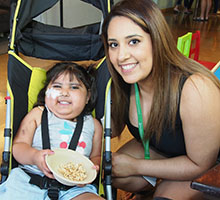Three-year-old Receives Lifesaving Heart Transplant
Doctors unlocked the underlying cause of her cardiac disease and now, the future is looking much brighter.
For Release: August 10, 2015
 Kate Leah Zuno, 3, is a smiling, happy toddler. Not uncommon for three-year-olds, but considering the last year and a half, “her ability to be so happy surprises me,” said her mother, Karen Vargas.
Kate Leah Zuno, 3, is a smiling, happy toddler. Not uncommon for three-year-olds, but considering the last year and a half, “her ability to be so happy surprises me,” said her mother, Karen Vargas.
It all started when she was a little less than a year old. Karen Vargas had a desperate plea. “No one had answers to why my baby was sick,” Vargas recalls. Now, Kate is on the upswing, thanks to receiving a heart transplant at Lucile Packard Children's Hospital Stanford a few weeks back. She is “doing great,” according to doctors.
This Cheerios-loving 3-year-old whose life has been saved by the ultimate gift of life is staying close to the hospital until September before returning to life in Ukiah, Calif., and finishing all those jigsaw puzzles and art projects she loves. When she returns, she will be way healthier than when she left.
Recalling the frightening time when Vargas was searching for answers, there was “something not right”, Vargas said. “I had to keep pushing for tests, as no one had answers why my baby was sick.” It took four months for Kate to be diagnosed with dilated cardiomyopathy, a virus attacking Kate’s heart. That brought her to our Heart Center.
Kate’s care team, which includes Stanford Medicine Children’s Health cardiology, genetics and metabolic disease experts, conducted avid testing to discover the underlying cause of Kate's cardiac disease. Tests included a thorough metabolic and genetic investigation, which resulted in Kate being diagnosed with a rare mitochondrial disorder which manifested symptoms primarily in her heart, but also can play a part in some developmental delays.
Mitochondrial disorders stem from failures of the mitochondria, specialized compartments present in every cell of the body except red blood cells. Mitochondria are responsible for creating more than 90% of the energy needed by the body to sustain life and support growth.
While Kate did well on oral medications and close collaborative follow-up from the pediatric advanced cardiac therapies (PACT) and metabolic disorders teams for almost two years, but things got worse this past March. What Vargas thought to be a stomach virus brought them back to the hospital. It turned out to be a sign of further heart failure. With her condition deteriorating rapidly, Kate was placed on ECMO heart and lung support for four days in the cardiovascular intensive care unit.
“Difficult decisions regarding longer term therapeutic options had to be made,” said cardiologist Beth Kaufman, MD. “She would not be able to survive for long in that state of heart failure.”
Many children with mitochondrial diseases continue to have deterioration in their whole bodies that often cannot be helped with cardiac support alone, and may even become worse with heart transplant due to the need for immunosuppressive treatments. Kate's doctors reached out to other experts in the field to survey similar experiences with children having a comparable set of medical challenges.
“The unknown factors loomed,” said Kaufman. “Would her body tolerate the necessary procedures, weakened immune system, and medications after transplant? But with our research of comparative cases, the medical team decided moving forward with transplant was Kate’s best option.”
That changed everything. After a couple of months on lifesaving bridge-to-transplant technology known as the Berlin Heart, Kate received a donor heart June 20. Although she will need to continue medication to treat her mitochondrial disorder, her new heart allows for much improved health and the ability to live without fear of heart failure.
For Vargas and her daughter, this next year is all about recovering and getting Kate ready to enter kindergarten when she turns five. “I want to help her have the same occupational capabilities as kids her age,” said Vargas, “and my hope is for her to live as normal life as possible.”
Now learning to live a new norm of an endless supply of anti-rejection medicines, Kate and mom are ready to head home. Kate will continue to undergo speech, physical and occupational therapies. Her feeding tube, which has been in place for the better part of a year, is expected to be removed soon.
“She and I are building our routine, and this includes teaching Kate about what’s happened so far and what she needs to grow strong—and being thankful for this lifesaving gift.”
Authors
Samantha Dorman
(650) 498-7056
sdorman@stanfordchildrens.org
About Stanford Medicine Children's Health
Stanford Medicine Children’s Health, with Lucile Packard Children’s Hospital Stanford at its center, is the Bay Area’s largest health care system exclusively dedicated to children and expectant mothers. Our network of care includes more than 65 locations across Northern California and more than 85 locations in the U.S. Western region. Along with Stanford Health Care and the Stanford School of Medicine, we are part of Stanford Medicine, an ecosystem harnessing the potential of biomedicine through collaborative research, education, and clinical care to improve health outcomes around the world. We are a nonprofit organization committed to supporting the community through meaningful outreach programs and services and providing necessary medical care to families, regardless of their ability to pay. Discover more at stanfordchildrens.org.
Connect with us:
Download our App: